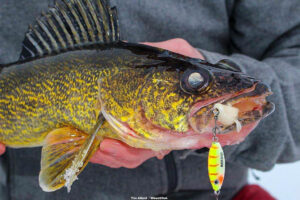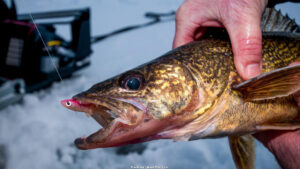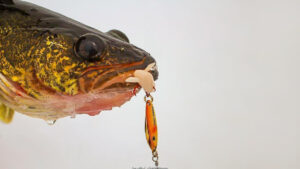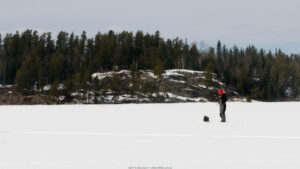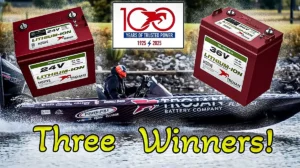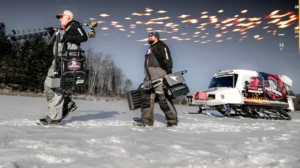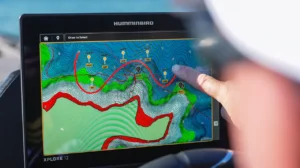Soft-bait popularity steadily grows across the ice fishing belt. The micro-plastic craze has definitely picked up for bluegill, crappie and yellow perch. Walleye anglers, too, embrace the durability, realistic finishes, scent properties and finesse actions of soft baits. Plastics are also an alternative for live bait in many scenarios. If you’re not carrying soft plastics on the ice, this is the winter to start.
Jeff “Gussy” Gustafson offered to help explain the virtues of soft-plastics for walleye in winter. Well-known as a Walmart FLW Tour competitor, Gussy’s also a hard-water, multispecies expert and guide, specializing in trophy fish in Northwest Ontario’s Sunset Country Region.
Here are 4 reasons to use soft-plastics when ice fishing walleye:
- Less mess
- Realism
- Unique actions
- Added attraction
Live-bait alternative
Plastics can be more practical and convenient than live bait. Many times it’s easier to bring soft baits instead of a minnow bucket.
- Real McCoy prohibited – In certain regions, live bait is not permitted. Soft plastics are a worthy substitute for jig-and-minnow presentations or for tipping lures.
- Less hassle – Soft plastic minnows are convenient. Real ones require pick-up at a bait shop and care to keep lively.
- Better in the cold – Soft plastics are more resilient to cold. A real minnow can turn to a frozen fish stick in the time it takes to walk from one hole to another. If anything, plastic minnows are worth carrying as backup in case the real ones die.
- Better travelers – “Another benefit to using plastic is that you can be so much more mobile,” Gustafson said. “If you’re on the move drilling a lot of holes or fishing remote waters where you are limited to what you can carry, all you need to do is put a few bags of plastics in your pocket and you can still catch fish.”
- Resilient – Gustafson regularly jigs aggressively to trigger strikes from walleye. He prefers rigging a jig with a plastic minnow because it stays on the hook. A real one tears off. A plastic bait is also less likely to foul when assertively jigging.
- Plastics take abuse – “When you get on a hot bite, not having to rebait means you can get your bait back down the hole quickly and catch more fish,” Gustafson said.
Avoid the plunge – Using plastics doesn’t require holing a wet, cold minnow. This helps keep hands warm and maintains dexterity needed for finesse jigging. Your fingertips will thank you.
Get real
Walleye are more apt to scrutinize baits in cold water. This is especially true in clear water lakes. Overall, water clarity tends to increase in winter. There is no wave action to stir-up a lake, and algae blooms don’t occur. As such, replicating specific forage often hooks the fish.
“I catch a lot of walleyes on Northland Buck-Shot Rattle Spoons and Puppet Minnows, but there are times when a jig tipped with a 3-inch Northland Impulse Smelt Minnow or a Jackall Clone Fry are better,” Gustafson said. It’s all about experimenting. On Lake of the Woods, smelt are a big part of the diet of walleyes in the winter, so these soft baits do a great job of replicating the size and profile of these smelt.”
“It took a long time for anglers to become comfortable using soft plastics for walleyes in open water and now they are commonplace. Soft-plastics work under the ice as well. Anglers just need to experiment and find out what works best for them under different conditions.” – Jeff “Gussy” Gustafson
Gustafson rigs a 3-inch Northland Impulse Smelt Minnow on a Northland Vegas Jig, working it near bottom when walleye are tight to structure. When walleye suspend around humps, a larger 4-inch Smelt Minnow attracts them better. This is rigged on a Northland Slurp Jig with a 3/0 hook. A 1/4-ounce jig is used most days for fishing 20 to 30 feet of water. He sticks with pearl, smelt and other natural colors.
In ultra-clear water, Gustafson prefers the Clone Fry for its lifelike finish in Ghost Minnow and Threadfin Shad. He cuts the head off at the nose to ensure a flush, natural profile when tight against a jig.
Smelt are just one example of soft-plastic impersonations. Yellow perch, shiners and dace are commonly available plastic patterns.
Small worm, nymph and other creepy-crawly soft-baits are also available. Downsizing and finesse jigging can be a grind-it-out approach, but it catches inactive, daytime walleye. It’s a good option when aggressive jigging isn’t triggering reaction strikes.
Unique actions
Walleye are also tempted by the unique and subtle action of soft plastics. Whale and forked tails on minnows cause them to glide. Aggressive snaps deliver an erratic, darting action. Both movements attract fish. Quivering a minnow after a pause so its tail shakes nervously often stimulates strikes.
| Gussy’s Ice Tools
Gustafson jigs with a Frabill Ice Hunter 38-inch heavy rod he helped design. He prefers this beefier jigging outfit with a fast tip given the above-average sized walleye prowling Lake of the Woods and other Northern Ontario waters he fishes. It’s outfitted with a Shimano Stradic 1000 reel, 10-pound Power Pro ICE line and an 8-pound fluorocarbon leader, typically 3 feet. |
Anglers often overlook a tube, an effective plastic for walleye. It’s slow spiraling fall replicates a dying baitfish. This action is silhouetted against the bright sheet of ice. Instincts kick in when walleyes see the sinking tube, rushing to claim the easy meal before another one beats them to it.
Years ago an angler in our group smashed walleye using a 2-inch, pink and white tube. One after another, walleye rushed up and grabbed the slow-sinking bait like shopaholics at a Black Friday bargain bin. In addition to its spiraling, his presentation was effective because of the tube’s slow fall courtesy of a 1/16-ounce jighead.
A tube also works near bottom. Hopping it replicates a feeding minnow. Small shakes wave tentacles and trigger hits. A chewy texture and scent encourage walleyes to hold on.
Tip: tie-in a barrel swivel 18 inches up the line to prevent twist caused from a tube’s spiraling action.
Sweetening hard-baits
Tipping hard-lures with a soft-plastic adds color, boosts scent and enhances action. Here are 3 reliable methods:
- Artificial minnow head – Add one to the bottom of a jigging spoon or centre treble of a jigging minnow. Skewering the head with the treble’s shank is the most durable and balanced method.
- Finesse minnow tail – Gustafson also tips a Puppet Minnow’s rear hook with a plastic minnow tail. The plastic boosts color and adds a quivering action.
- Tube tail – Take the hook off a jigging spoon and set it aside. Trim a 1 1/2- or 2-inch tube, leaving 1/4- to 1/2-inch of the body remaining above the tentacles. Insert the treble hook into the tube’s cavity. Reattach to the jigging spoon. This addition drives walleye wild on a shake-pause sequence.
Tip: Add a drop of high-strength glue to a jig head’s collar before snugging up a soft-plastic for extra durability.
“Today’s soft plastics are so realistic and scented to trigger fish to strike,” Gustafson said. “On a tough bite, I will still use a piece of meat, but on most days, especially in my part of the world in Northwest Ontario’s Sunset Country Region, you really don’t need to use meat.”
Try the above soft-serve tactics for walleye this winter. A break from your normal routine and adding scent, action and color to your presentations can pay big dividends on your ice outings this season. Remember to experiment, as there are many other plastic profiles available beyond what’s discussed in this article.
Tim Allard is a hard-water fishing expert and author/photographer of the award winning book Ice Fishing: The Ultimate Guide.



